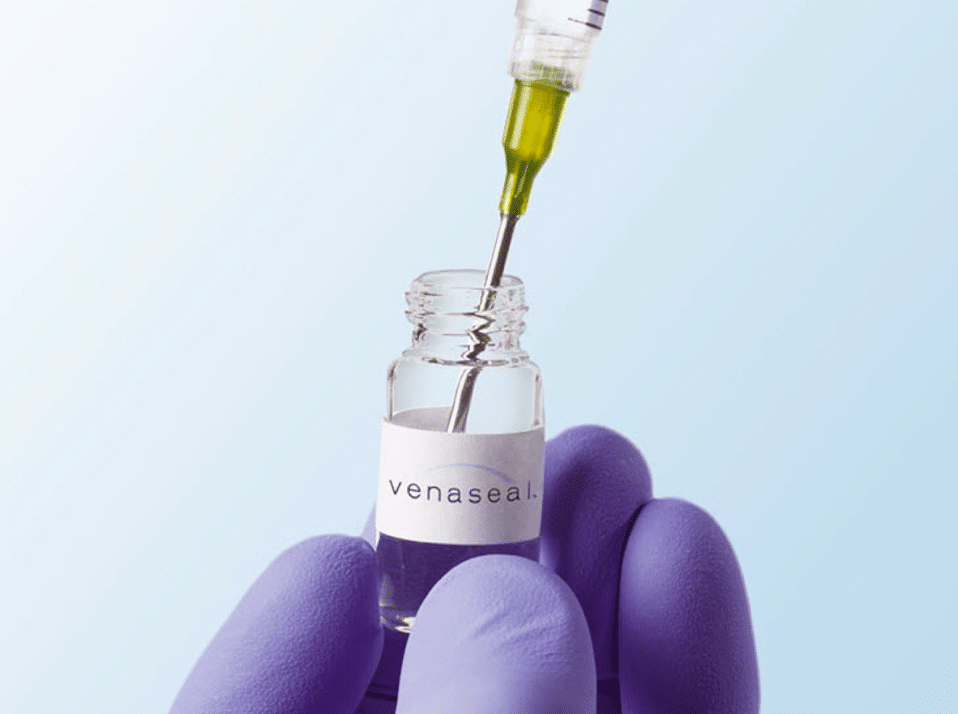Are you frustrated with your varicose veins? If you are, you can look into VenaSeal to get rid of them. VenaSeal uses a safe and patient-friendly medical glue…
What Is VenaSeal Treatment?

Are you frustrated with your varicose veins? If you are, you can look into VenaSeal to get rid of them. VenaSeal uses a safe and patient-friendly medical glue to close a damaged vein. This will improve the appearance of your legs as well as help the symptoms associated with varicose veins.
VenaSeal has been tested throughout the U.S. and Europe for the last five years. Results have shown excellent results and a low risk of complications. For example, a VeClose study in 2017 observed 97% closure at 12 months.
Read on to learn more about how to get rid of varicose veins with VenaSeal.
What Is VenaSeal?
Developed by interventional radiologists, VenaSeal uses a medical glue called VenaSeal to seal the defective vein.
Specifically designed to treat varicose veins, VenaSeal glue is a patented product based on an adhesive that has been used in medicine for over 50 years. It is antimicrobial and has no adverse long-term effects.
Once VenaSeal glue goes inside your vein, it will quickly seal the vein shut. Since the glue is elastic and soft, you won’t feel a thing as the walls of your vein come together. Your vein will then harden and be gradually absorbed into your body. Blood will automatically be routed through other veins.
Unlike other methods of varicose vein treatment, such as endovenous laser ablation (EVLA) or radiofrequency ablation (RFA), VenaSeal is a minimally invasive procedure that only requires one small incision of about two to three millimeters. As such, VenaSeal requires very little local anesthesia.
VenaSeal also offers the following benefits:
- No drugs or sedatives before, or during, the procedure
- No need for uncomfortable gradient compression stockings after the procedure
- No leg wrappings after the procedure
- No risk of skin burns or nerve damage
- Usually, no need for pain medication — although sometimes it can help
What Kind of Results Can Be Expected From VenaSeal?
After the procedure, you can expect to see results within one to two weeks. In some cases, you will get immediate relief from the painful symptoms you’ve been experiencing as a result of your varicose veins.
VenaSeal gives effective long-term results. Three clinical studies have demonstrated that VenaSeal can give you closure rates of up to 94.7% three years after treatment.
How Much Does VenaSeal Cost?
A VenaSeal session costs around $3,000 on average.
The cost depends on where you live, the severity of your varicose veins, and your insurance coverage — deductibles, copays, and more. If your insurance doesn’t cover VenaSeal, your specialist may offer a cash rate.
What Are the Risks of VenaSeal?
Potential complications and risks come with undergoing VenaSeal. In some cases, treated varicose veins can get inflamed and you may have to take anti-inflammatories. However, you will also face this risk if you choose to undergo other varicose vein treatments, such as EVLA.
There is also a small possibility that you may be allergic or hypersensitive to the VenaSeal adhesive. Talk to your doctor about your medical history and current health to get more information about the risks of getting VenaSeal.
How Can Patients Prepare for VenaSeal?
Keep the following in mind as you prepare for VenaSeal:
- Avoid shaving your legs before the session or applying moisturizer to your legs on the day of the treatment.
- Don’t stop taking medications before your VenaSeal session unless your doctor has advised you to do so.
- You should be wearing loose pants and a pair of comfortable shoes to your VenaSeal appointment.
What Happens During a VenaSeal Session?
A typical VenaSeal session takes place at your vein specialist’s clinic and lasts around 30 minutes.
Once you arrive at the clinic, your vein specialist will inject anesthesia into the area where they will access your vein. After anesthesia is applied, VenaSeal vein glue will then be injected into your varicose vein through a small catheter.
You will feel some pressure as the catheter is put into your leg and slowly removed. Your doctor will also be using ultrasound to make sure the catheter is reaching the right places.
After all the glue has been put into your vein, the catheter will be removed and the doctor will apply dressing on your puncture site.
When Is VenaSeal the Right Treatment Option?
VenaSeal is ideal if a patient prefers a stocking-less solution for treating varicose veins. This is its main benefit over other treatment options.
However, VenaSeal is not a good option if you want to remove spider veins. Although spider veins — like varicose veins — are also caused by damaged or weak valves in your veins, they are not big enough to be effectively treated using VenaSeal.
VeinWave, VeinGogh, sclerotherapy, and cutaneous laser treatment are better ways to treat spider veins since they specifically target smaller veins to collapse them.
Consult a vein specialist to discuss the best treatment for your varicose veins.
What’s the VenaSeal Recovery Period Like?
After a VenaSeal procedure is done, your doctor will apply a small bandage on the access site and you will be ready to go.
Most patients report feeling very mild to no pain during and after the procedure. As such, you can immediately return to normal activities after getting VenaSeal.
How Many VenaSeal Treatment Sessions Are Needed?
Most patients only need to have one or two sessions. Typically, one vein will be treated per session.
Are You Ready to Consult With a Vein Specialist?
VenaSeal is a great way to accomplish varicose vein removal. However, before you book a VenaSeal appointment, you should always seek the advice of a board-licensed specialist.
Try using our vein specialist locator tool to find a vein specialist near you. Talk to them about the best treatment for your varicose veins.






Responses